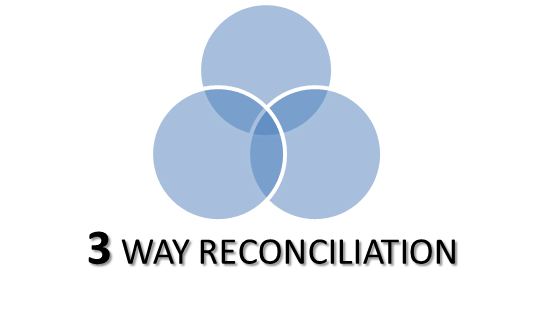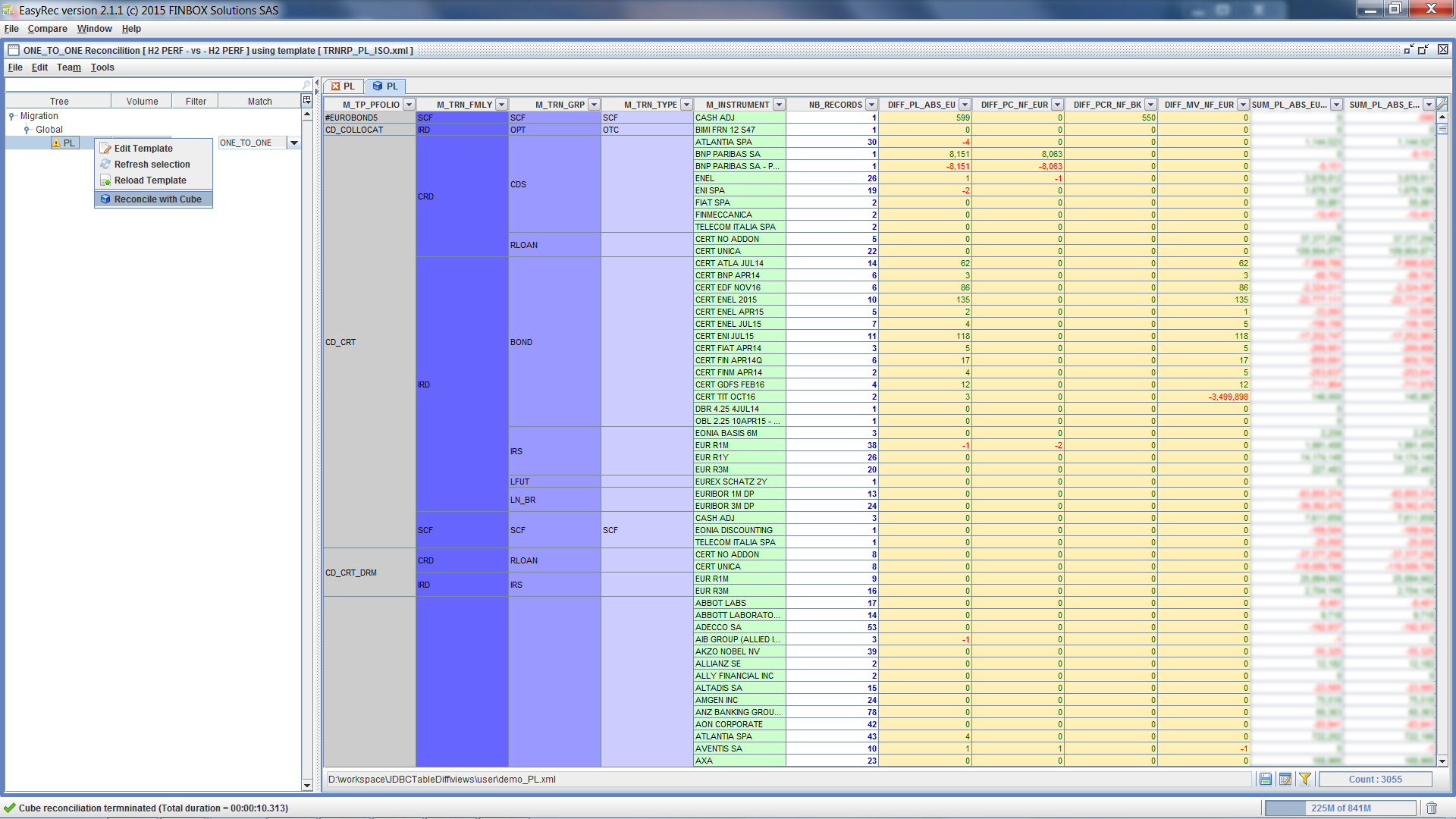EasyRec
EasyRec is a generic and flexible reconciliation solution which can compare agnostic data sourcesRECONCILIATION CHALLENGES
Generic reconciliations, migrations, inter-system reconciliations and upgrades are constantly dealing with complex reconciliations and monitoring requirements.
Source data must be retrieved, converted, adapted and cleansed before being imported to the correct target environment. Common issues are related to the volume of data, complexity of transformations and the capacity of integration in a target environment.
Some of The Issues our Customers Faced
- Current solution created a difficult learning curve for mainstream users.
- High complexity and cost of maintenance.
- Expensive user license costs.
- Solution knowledge focused on a few people.
- Need for technical support from IT.
- Many manual reconciliations still done in Excel.
- No support of large data (>1 000 000 rows).
- Need for automation (under Windows and/or Unix).
- Need for Mappings
- Poor exception management handling.
- Limited or No intuitive workflow to validate breaks.
- Need for Root Cause assignment.
- Lack of support for agnostic sources (SQL, CSV, Excel, flat files, JSON, XML, …).
- Need for KPI’s and KRI’s.
Benefits of EasyRec
- Plug and Play.
- No need for additional hardware costs.
- Minimal learning curve.
- Reasonable commercial costs.
- No dependency on IT.
- No internal IT costs.
- Automate existing manual reconciliations.
- Eliminate operational risk.
- Reconciliations can be executed by batch
- Support for Mappings
- Robustness and performance.
- Workflow validation of breaks.
- Support of Root Cause assignment.
- Data agnostic.
- Automated report generation (Excel, PPT, tables).
- Real Time KPI and KRI dashboards.
SHIFT LEFT <<
Identify discrepancies at the early stages in the life cycle prevent from harm due to late testing. By testing early and often, a project can reduce the number of bugs and increase the quality of the code
-
-
- Prevent from loss of code
- Increase robustness of merge
- Find bugs early on in the software development life cycle
- Reduce the cost of solving bugs by detecting them early on
- Gain a higher-quality product as the code contains fewer patches and code fixes
- Have fewer chances that the product overshoots the estimated timeline
- Provide higher customer satisfaction as the code is stable and delivered within the budget
- Maintain higher-quality codebase
-
ADDED VALUES
-
- Data inspector to guide users to analyze raw data and select relevant reconciliation keys, as well as columns to ignore
- Clients can leverage on the recursive configuration to create their own practices
- Factorize and re use configuration with template model and Dynamic variables
- Create set of pre defined templates to cover specific business requirements
- Increase level of control, allowing clients to easily compare distinct environments and identify changes.
- Monitor data (database, CSV, Excel, XML, Swift, …)
- Monitor changes in application directory or GIT branches ( orderless XML compare, …)
- Advanced features:
- OLAP Cube reconciliation is very useful for migration project, providing customizable breakdown and granularity in the reconciliation.
- Our unique “Snapshot reconciliation” allows users to easily understand complex datamodel
- Automatic split of large reconciliation into smaller business reconciliation reports to simplify the analysis
CONTINUOUS INTEGRATION CONTINUOUS DEPLOYMENT
Cost reduction and increasing need for automation are leading our clients to implement CI/CD. However return on investment can easily look a lot less attractive.
Most of our clients have multiple environments and face the need to secure configuration management in order to increase level of control and to make sure environments are aligned.
Ignoring configuration management reconciliation can at best lead to missing code and wrong data in your system. At worst, it can lead to project delay and massive cost overruns.
EasyRec can connect to any configuration source (local files/folders, ZIP archives, GIT repositories, SSH) and users benefit from flexible and customizable reconciliation features.
-
-
- Flexible filename matching rule
- XML order-less comparator
- Ignore indentation, blanks, DOCTYPE
- Ability to perform transformations (ex: get rid of unique IDs, …)
- Support for regular expressions
-
OLAP CUBE RECONCILIATION
Traditional 2ways one to one reconciliation may not always be the correct approach for data reconciliation.
Data migration project is a good example as client can decide to migrate data by position which result in difference in the number of entries in the target system.
Data migration approaches:
-
- Consolidation: consolidating multiple instances into one
- Migration: Migrate from and old system to a new one
- Upgrade: Upgrade existing system to a more recent version
- Integration: Migrate multiple sources into multiple target environments
Given the potential complexity of a data migration project (ETL, mappings, migration by position…), a possibility is to run a reconciliation on aggregated positions, but in this case, you will loose the capability to drill down to lower level of information.
Cube analysis is particularly well adapted for this scenario. Data from dimensional data warehouse is loaded into a cube so that business users can browse the cube to analyze the data. Browsing a cube means slicing and dicing the data to get the breakdown of the measures by the dimensional attributes.
Using a reconciliation cube, testers will have the ability to create their own calculated fields which will individually be evaluated by customizable breakdowns. They can easily identify whether a difference is expected or not. Within the same view, cube reconciliation can provide both aggregated and detailed figures, facilitating the acceptance and validation processes.
Reproducing manually the result of a cube means processing hundred of “select from where group by” queries against source and target data sources. Lots of valuable time, efforts and money are usually spent on this type of reconciliation.
3WAY RECONCILIATION
3 way reconciliation relies on reporting Trial Balance.
It can be used as a procedure for discovering shortages, errors or omissions that must be corrected in relation to an Escrow Trust Account.
-
- Data can be expanded with user-defined formulae
- User-defined Pivot table for quick analysis by aggregated positions
KPI & Analytics
EasyRec offers broad range of KPI, from the technical figures (match ratios) to some more functional indicators such as breakdown by user activity, break classification…
Pivot analysis
Reconciliation is not only a matter of number of breaks. Business wants to know the impact on their activities with the ability to analyze aggregated data according to user defined breakdowns
The embedded Pivot table allows users to analyze data by aggregated positions with drill down capabilities.
Validation workflow for breaks
The embedded User Comments module allows users to categorize, prioritize, assign, validate breaks and more…
-
- Audit Trail
- Versioning
- Bulk insertions/updates of User Comments
- Validation workflow (Not analyzed, In progress, Accepted, Rejected)
- Exception Management: force match
- Root Cause assignment with Best Matching Rules
- Automatic creation of User Comments via Business Rules
Performances & Scalabilities
Performance increases linearly with volume
-
- 100,000 rows with 50 columns, can be reconciled in 3 seconds (using 5 reconciliation keys)
- 1,000,000 rows with 50 columns, can be reconciled in 30 seconds (using 5 reconciliation keys)
Scalabilities
-
- Support Lazy mode for large data
- 50 millions rows with 51 columns can be reconciled in 35 minutes by a single engine
- Number of reconciliation engines can be increased
- Divide and conquer strategy: large reconciliations can be automatically splitted into sub reconciliation reports

Usage
- IT : Support, Config management & version control
- Compare different environments
- Compare database objects (tables, indexes, Blobs, …)
- Regulatory : Compliance procedures
- Back Office : Payment reconciliation, swift
- Non regression testing : Reconcile all data extractions
- Front Office and Risk Control : P&L, Cash Flows, Static Data and Trade reconciliations
- Liquidity Management : Nostro reconciliation
- Market Data : Comparison between different Desks
- Risk : Comparison of Sensitivities, Scenarios, Greeks
- Finance : Accounting reconciliation
- CICD branches reconciliation: increase control and quality of deliverables






